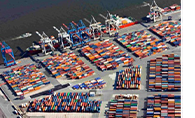Northern Sea Route: Arctic dreams, shifting tides of global trade play out in Russia
 The Northern Sea Route (NSR), a 5,600-kilometre maritime corridor carved along Russia’s Arctic coastline, has emerged as a contested and evolving gateway between Europe and Asia. The Northern Sea Route (NSR), a 5,600-kilometre maritime corridor carved along Russia’s Arctic coastline, has emerged as a contested and evolving gateway between Europe and Asia.
Once a frozen frontier suited only to the daring and ice-reinforced ships, now stands at the intersection of climate change, geopolitics and logistics - its prospects made more compelling by the fragility of traditional routes and the growing influence of Arctic partisans.
Before the Russo-Ukrainian war, Western shipping interests approached the NSR with cautious optimism. In 2018, Danish liner giant Maersk tested the waters by dispatching the 3,600-TEU Venta Maersk along the route. The passage, while technically viable, failed to deliver commercial success.
Maersk cited limited demand, insufficient infrastructure, and navigational uncertainty as reasons for declining regular use. The verdict from Copenhagen was clear: the NSR was not ready for prime time - at least not for the container trade.
Since then, the corridor has taken a distinctly eastward turn. Chinese shipping companies, largely state-owned or state-aligned, have embraced the NSR - not as a substitute for container flow between Rotterdam and Shanghai, but as a conduit for bulk energy resources.
Vessels from ports such as Tianjin, Qingdao and Dalian increasingly navigate northward to Russia’s Yamal Peninsula, home to vast reserves of liquefied natural gas (LNG) and crude oil. These voyages form part of a broader energy axis, where Chinese financing underpins Arctic LNG development and helps secure long-term resource flows, bypassing Western-regulated choke points.
Chinese traffic via the NSR is driven predominantly by energy demand. According to data released in 2023, nearly 95 per cent of cargo originating or terminating along the route had links to China. The trade patterns are distinctly asymmetrical. Most voyages from China to Yamal return in ballast or via alternate routes, reflecting the nature of bulk cargo movement.
Container traffic remains marginal and episodic. During the 2023 summer season, four Chinese box ships delivered a combined 17,000 tonnes of containerised goods to Arkhangelsk and Murmansk. Only two returned with 11,000 tonnes, underscoring limited backhaul capability and the absence of a true two-way container market.
East-West transits - where ships traverse the entire NSR corridor from the Pacific to the Barents Sea - are still a statistical minority. Less than five per cent of voyages in 2023 constituted full transits. Instead, the route is characterised by directional bulk movements from Yamal to European ports such as Murmansk, Arkhangelsk and onward to Belgium, France and Spain.
That flow too is changing: with European sanctions tightening and transshipment bans becoming law in 2025, the share of Yamal exports bound for Western Europe is expected to contract significantly.
The NSR’s viability hinges on seasonal accessibility. Traditionally navigable for just over two months, the summer window has expanded notably due to retreating Arctic ice. In 2021, ships traversed the corridor for a record 88 days, stretching from early August into late October. By 2024, reliable navigation extended from July to November—an unprecedented five-month period. During this window, ice-class vessels reign supreme, though there is increasing deployment of standard ships during the mid-season peak, particularly in September and October.
Geopolitics has cast a long shadow over maritime trade, particularly in the Red Sea and Suez Canal. Houthi attacks and elevated insurance costs have made the traditional routes increasingly hazardous. While the NSR cannot yet match the Suez in infrastructure or throughput, it offers compelling strategic advantages. For Beijing, the NSR lies beyond the purview of the US Navy and Western-led sanctions regimes. For Moscow, it provides direct access to Asian markets, particularly as Europe turns its back on Russian hydrocarbons.
Containerised trade on the NSR remains an exception rather than a norm. The route lacks the port sophistication required for rapid box turnover, and the unpredictable weather undermines schedule reliability. However, bulk shipping has flourished. Crude oil, LNG, coal and iron ore dominate the cargo mix. In 2023, bulk carriers transported over 416,000 tonnes of coal and ore to Chinese ports. LNG shipments surged, with Novatek’s Yamal LNG project dispatching 234 tankers to Europe and Asia, despite geopolitical headwinds. This illustrates that while containers lag, bulk flows are buoyant.
Cargo throughput on the NSR has witnessed steady growth over the past decade. In 2015, volumes stood at under 5 million tonnes. By 2020, throughput had climbed to 33 million tonnes. In 2022, it reached 34 million tonnes, with a further increase to 36 million tonnes recorded in 2023. Russia’s Arctic development blueprint envisions staggering growth - targets of 80 million tonnes by 2024 and 240 million tonnes by 2035 have been outlined. However, analysts caution that such figures may be aspirational, especially if sanctions persist and infrastructure investment lags.
The NSR is not a cure-all for global maritime woes. It is a niche corridor, shaped by climate shifts, geopolitical entanglements and the rhythm of commodity markets. Its strengths - strategic bypassing of contested waterways and closer proximity between East Asia and European Russia - are real. Yet its limitations, from shallow ports to fragile ecosystems and minimal search-and-rescue capacity, cannot be overlooked.
Still, as the ice recedes and trade routes face mounting disruption, the Arctic corridor’s relevance inches upward. Where once explorers dreamed of polar passages, today politicians and executives examine tonnage metrics and energy maps. In that transformation, the NSR has shed its mystique and gained a new identity - not as a global thoroughfare, but as a regional artery pumping the lifeblood of Arctic ambition. |